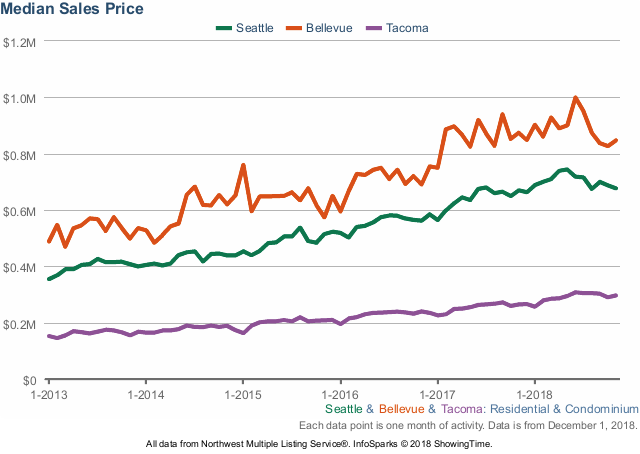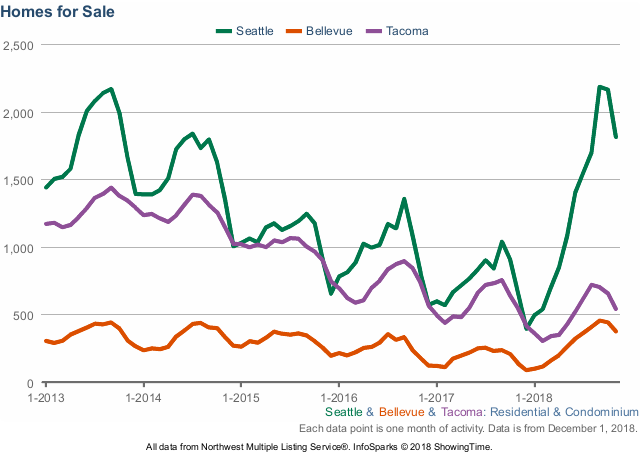CoBuy Greater Seattle Housing Market Update – Dec 2018

“Those who have knowledge, don’t predict. Those who predict, don’t have knowledge.“ -Lao Tzu
So long, 2018.
The curtain is closing on 2018, and it seems everyone has something to say about the housing market. Real estate reporters, social media soothsayers, and industry incumbents are all busy making predictions. Tis the season to make forecasts! It certainly makes one wonder.
Disclaimer: I do not have the winning lottery numbers, and I won’t do that here. Instead, I’d like to cover some of the key trends, data releases and macro developments that are likely to drive the market going forward.
At CoBuy, we help folks buy and own homes together, intelligently. We are not in the business of convincing anyone to buy a home. We work with folks who want to co-buy homes to do it more efficiently and, well, better. Our fundamental view is that better information enables better decision-making.
The big picture looks decent
The U.S. economy has performed well in 2018. GDP grew at an annualized 3.5% in the third quarter, unemployment is near its 50-year low, and we have experienced a period of strong wage growth. If the national labor market is strong, the same can be said of Greater Seattle. The current unemployment rate for King County is 3.4%. Seattle Metro Area wages and salaries are growing at 3.7% annually. Forbes recently ranked Seattle #1 on its list of Best Places for Business and Careers while Tacoma came in at #10.
As we head into 2019, many economists expect the pace of national economic growth to temper but “remain strong”, though there are headwinds (geopolitics, corporate sector, trade deficit, fiscal policy, monetary policy, etc.). The Federal Reserve is expected to raise interest rates at the upcoming meeting in mid-December, and the market expects three further hikes next year. This follows a sustained run of historically-low interest rates which has fuelled the housing market and the broader economy. The timing of monetary tightening will be subject to domestic and global economic developments, of course.
Housing markets are normalizing
It’s been a good year for most homeowners in the U.S. Nationally, home values are up 7.7% over the past twelve months. We are now seeing a rebalancing of the supply-demand dynamic in many metro housing markets across the U.S. The latest national data shows existing home sales up 1.4% month-on-month, though the annualized rate is down 5.1% from last year (source: National Association of Realtors).
Rising mortgage rates are clearly feeding a cooling off in the housing market. In 2018, the average rate on a 30-year fixed rate mortgage has risen from 3.95% to 4.81%. As one might expect, the number of folks applying for mortgages has decreased as the cost of borrowing has increased. Future interest rate hikes are likely to reduce demand from prospective homebuyers as the cost of borrowing rises. This means that some folks who might have otherwise decided to buy a home will defer that decision, either voluntarily or necessarily. Many renters who would have transitioned from renting to homeownership will remain renters by necessity.
Heading towards ‘balanced markets’ in the Seattle Metro Area
In the Seattle-Tacoma-Bellevue Metro Area, home values are up over 7% over the past twelve months and over 60% over the past five years. By multiple measures, the market is showing signs of continued rebalancing. This is probably a good thing: the recent growth in home values has outstripped growth in wages and salaries significantly. Supply has been super tight and the market has favored sellers for years. One-sided markets can’t persist forever.
Median sales prices have come down off the highs seen in May and June of this year. But according to NWMLS data, in Seattle and Bellevue there have been notably fewer transactions of larger homes (those with four or more bedrooms) and of more expensive homes (priced at $1 million and over), both on a monthly and rolling three-month basis. This trend exerts downward pressure on the reported median sales price.
Note the difference between “listing price”, “sale price”, and “home value”. A home isn’t necessarily sold at the listing price: often times the sale price is above or below the listing price. Home value indices are constructed in the aggregate and should reflect the distribution and type of housing stock. If one month only “starter homes” are sold in a given geography, the median sales price data for that month will be relatively low and isn’t an accurate gauge for home values overall. Add into the mix seasonal swings and it becomes clear that data needs to be evaluated in context and with regard to the construction of the dataset.

The number of homes on the market has increased across King County after many months of excessively tight inventory. Still, months supply of inventory for Seattle, Bellevue, and Tacoma remains considerably lower than the 4-6 months considered “balanced”. Months supply of inventory represents how long it would take for all of the homes currently on the market to be purchased assuming no new homes were listed.


The median days on market has increased in Seattle (21 days), Bellevue (19 days), and Tacoma (18 days) from the low in June of just seven days. Compare that to the current national figure of 71 days. Furthermore, the median percent of last list price figure for Seattle last month came in at 98.9%, Bellevue at 98.4%, and Tacoma at 100%. Homes for sale in the region are still changing hands at a fairly brisk pace and within 0-2% of list price.
Co-buying means more bang for your buck
Like buying in bulk from Costco, buying a larger home is relatively cheaper on a per-bedroom basis than buying a one-bedroom home. On a per-bedroom basis, a three-bedroom home is 45% cheaper than a one-bedroom home in Seattle. Economies of scale are real, and combined purchasing power means more bang for your buck and greater optionality in terms of access to housing stock.
To demonstrate, let’s use current median list price data from Seattle. In our example, we’ll assume a 10% down payment and closing costs for the buy-side at 2.5%. Note: a 10% down payment isn’t necessarily required, and some borrowers qualify for mortgages with lower down payments.
The median list price for a one-bedroom in Seattle is currently $430k. In our example, a single buyer or couple would need to bring about $54k in cash to purchase this property.
At the current list price for a three-bedroom home, three individuals could each contribute just over $29k in cash towards the down payment and fixed costs. By pooling resources to jointly purchase a home, the financial hurdle to homeownership is substantially reduced.

Context is key
For anyone thinking about co-buying a home, it’s important to consider several factors:
- Motivations for the purchase
- Timeline
- Geography
- Personal finances
- Life circumstances
- Financing eligibility
- Interest rates
Decisions about if and when to buy should reflect your personal circumstances and those of any co-buyers. Let’s say I’m sure I want to buy a home within the next two years. Let’s also suppose that I decide to wait for a year to see what happens in the market. If during that twelve-month period borrowing costs increase by 50 basis points, property prices increase by 5%, and my rent increases, this could make it challenging to execute on my plan to purchase.
Related Posts
Curious about co-buying?
We're here to help, seven days a week.
